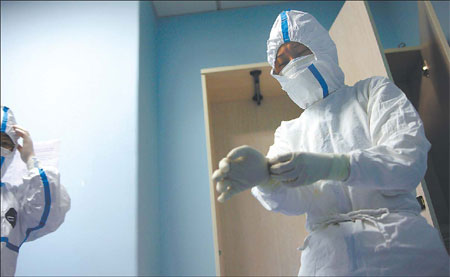Feeling an urgent need to use the toilet is the last thing you want when you are wrapped in a heavy-duty protective suit that takes you at least five minutes to put on and take off.
The nurses working at the No 2 infection subdivision at Beijing Ditan Hospital can tell you all about it.
Since the morning of May 2, when 14 people were quarantined after coming into close contact with an A(H1N1) influenza patient, cutting down on their daily water intake has been just one of the challenges they have had to endure.
|

|
|
Liu Xin (right), a nurse from the No 2 infection subdivision of Beijing Ditan Hospital, wears the special protective outfit before entering the isolation ward. [China Daily]
|
The disposable protective outfits medics must wear include an insulated anti-exposure body suit, two pairs of gloves, a mask, shoe covers and eye protection.
"Each time I peel the suit off after a day's work, it is glued to my skin with sweat," said nurse Liu Xin, who is tasked with regularly checking on the patients under observation and reporting any changes in their temperature or blood pressure to the health authorities.
As more suspected cases of the H1N1 virus come to light, more and more people are put in quarantine to stop the spread of infection among the general population.
Ditan Hospital is regarded as having the capital's best quarantine facilities and equipment, and also played a major role after the Severe Acute Respiratory Syndrome (SARS) outbreak in 2003, as well as deals regularly with cases of hand-foot-mouth disease.